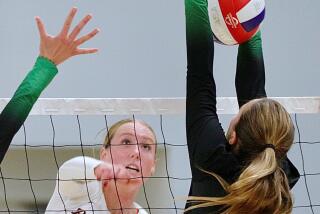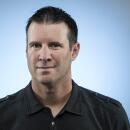Sport’s Legends in the Same Booth Now
- Share via
They slip on the headphones and get ready to work the microphones, looking for all the world like another comradely broadcasting team. But Karch Kiraly and Sinjin Smith haven’t been this close--or this friendly--in almost 20 years.
Then, they were tearing up the beach volleyball world as playing partners. Now they’ve been brought together--at least once a week, anyway, over Southland radio waves--by Leonard Armato, the player agent who bought the Assn. of Volleyball Professionals last year and is doing whatever it takes to promote his franchise, even if it means persuading former-partners-turned-enemies to make nice. So far, Smith and Kiraly side by side has worked. For an hour a week. For next to nothing.
“I’m not going to get rich on the radio show,” Smith said. “But anything I can do to help build the sport, I’ll do.”
As the AVP’s Michelob Light Manhattan Beach Open begins its main draw today, icons Smith and Kiraly still have the best perspectives and strongest voices in beach volleyball. Smith, 45, retired last year but remains an influential figurehead. Kiraly, 41, is the sport’s all-time leader with 143 tournament titles and is still an effective player, having won the Santa Barbara Open in June with Brent Doble.
Legends on the beach, they started playing together in tournaments way before prize money was offered and were the key charter members when the AVP was formed in 1984. They saw the tour rise and fall, and now are trying to ensure its rebound.
They have compiled a wealth of stories, and they offer predictions of the future of the AVP as it begins the fifth of seven events on this year’s tour.
*
Back when Smith and Kiraly started playing as a team in the late 1970s, there was no AVP, merely a loosely organized string of Southern California tournaments publicized by word of mouth. There were no player rankings, no statistics, no records kept.
And no cash prizes. Ice chests and beach chairs were given to the winners.
“If there were beverages in the ice chest, it was a big bonus,” Smith said. “If you got a new volleyball, you were stoked. Nobody was making any money back then.”
Summer days were endless for the beach boys, who would play on the sand from sunrise to sunset, arriving early in the morning, staying all day, trying to avert a loss that would knock them off the main court. Then there were the actual tournaments. After hitting the sand during the day, players would hit the bars and parties along the coastline.
“Everybody went from the beach to drink and dance and have fun,” Smith said. “Some of the top players would end up going out on Saturdays and would show up Sunday half-drunk. They’d sweat it out and play the best when they had to.”
Said Kiraly: “There was a lot less responsibility. Almost none of the guys were married, none of them had kids. It was a lot of wild, immature guys who had fun playing beach volleyball and all the things that went along with it.”
Back when Kiraly and Smith were friends, and winning, it was fun for them too. Out of college and playing for no pay, they couldn’t afford hotel rooms, so they crashed in an unusual place.
“Sinjin was car-sitting for a buddy of ours who had a VW van,” Kiraly said. “It was convenient because we didn’t have to scrounge around to find a place to sleep.... Of course, the van never started up unless we jump-started it. We had to park it downhill, with the emergency brake on, in order to jump-start it.”
The fans shared the beach volleyball lifestyle, camping out for days so as not to miss out on prime seats for Manhattan and Hermosa. By Sunday, fans were stacked 15 to 20 rows deep around main court, the nearest ones less than two feet from the sidelines, oohing and aahing every block and kill.
“That was one of the special things,” Kiraly said. “They’d literally be inches from the court.”
If the AVP put beach volleyball on the map, it also changed things.
Travel schedules became an issue. In 1984, the first AVP season, there were 18 tournaments, 14 in California. But three years later, there were 26 tournaments, only 11 in California. Flying time was replacing some of the previous playing/practice time.
Endorsement deals further reduced time in the sun as players spent more time pitching beachwear, sun block and volleyballs.
“The sport becoming professional took us off the beach,” Smith said. “Guys weren’t playing all day long, all the time. You saw guys setting up two-hour practice slots instead.”
Smith and Kiraly, former teammates at UCLA, split in 1984. Kiraly went the indoor route and won Olympic gold medals in 1984 and 1988. Smith stayed on the beach, winning a record 113 tournaments with Randy Stoklos.
Smith, however, feuded with the AVP players-only management and ultimately chose to play almost solely on the newer international tour after the 1993 season. Kiraly had returned to the AVP by that time, and he and new partner Kent Steffes became that tour’s top duo.
Smith forged a new career on the international tour and helped beach volleyball become an Olympic sport in 1996. However, the Federation Internationale de Volleyball, which ran the international tour, set the ground rules for Olympic qualifying, ignoring protests by AVP players, turning Smith and Kiraly into bitter enemies. When they met on the sand in the ’96 Atlanta Games, Kiraly partnered with Steffes, Smith with Carl Henkel, they played a match that will forever be the standard for measuring quality beach volleyball, Kiraly and Steffes winning in overtime in the quarterfinals, 17-15.
Kiraly-Steffes then went on to beat Mike Dodd and Mike Whitmarsh, another AVP duo, for the gold medal but that was the AVP’s high point. Saddled with debt, the result of poor management decisions and overly lucrative player payouts, the AVP filed for bankruptcy in November 1998.
“It killed me to see what happened to the AVP in the mid-to-late ‘90s,” Smith said.
But Smith, who’d had a longtime friendship with Armato, was brought back into the AVP fold last season and retired after finishing ninth with George Roumain at Manhattan Beach.
He and Kiraly are now ... friends?
“I think it’s a testament to who we both are,” Smith said. “No matter what’s gone on in the past, we can both stand up and promote the sport, not only individually but side by side. The sport is that important that you can put everything aside to help benefit it.”
The new AVP has shown some growth this season. Attendance has increased at the first four tournaments, and NBC will televise the next two, at Manhattan Beach this weekend and next weekend at Chicago, renewing the network’s relationship with beach volleyball for the first time since 1997.
“I’m sure it will be at a high-fever pitch at Manhattan Beach and Chicago, which is something we haven’t had in many years,” Kiraly said.
In the long run, Smith thinks the AVP’s popularity will prevail.
“Break down our sport, piece by piece ... there’s no reason why this sport can’t become a major sport in the world,” he said. “Look at the Olympics. Look at the attention, the crowd, the enthusiasm that it got at the Olympics.
“I guarantee [Armato] did not get involved in the sport to bring it back where it was. He wants to get it bigger than it was.... I have a good sense of the sport, its components and how it can be sold to the public. It may take 10 years, 15 years, maybe 20, but we will get there.”
*
(BEGIN TEXT INFOBOX)
Beach Volleyball
Who: Assn. of Volleyball Professionals.
What: Michelob Light Manhattan Beach Open.
When: Women’s final today, 1 p.m.; men’s final Sunday, 1 p.m.
Where: South of the Manhattan Beach Pier. Admission is free.
Top women’s teams: Holly McPeak and Elaine Youngs; Barbra Fontana and Dianne DeNecochea; Jenny Johnson Jordan and Annett Davis.
Top men’s teams: Eric Fonoimoana and Dax Holdren; Mike Whitmarsh and Canyon Ceman; Kevin Wong and Stein Metzger; Karch Kiraly and Brent Doble.
More to Read
Go beyond the scoreboard
Get the latest on L.A.'s teams in the daily Sports Report newsletter.
You may occasionally receive promotional content from the Los Angeles Times.











